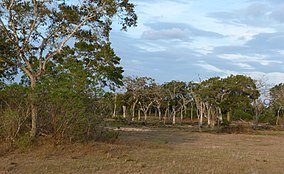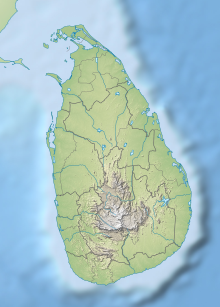Lunugamvehera National Park
| Lunugamvehera National Park | |
|---|---|
| ලුණුගම්වෙහෙර ජාතික වනෝද්යානය | |
 Landscape with elephant at Lunugamvehera National Park | |
| Location | Uva province and Southern province, Sri Lanka |
| Nearest city | Hambantota |
| Coordinates | 6°23′N 81°14′E / 6.383°N 81.233°E |
| Area | 23,498.8 ha (58,066.8 acres) |
| Established | December 8, 1995 |
| Governing body | Department of Wildlife Conservation |
Lunugamvehera National Park (Sinhala: ලුණුගම්වෙහෙර ජාතික වනෝද්යානය) in Sri Lanka was declared in 1995, with the intention of protecting the catchment area of the Lunugamvehera reservoir and wildlife of the area. The national park is an important habitat for water birds and elephants. The catchment area is vital to maintain the water levels of the five tanks in the down stream of Kirindi Oya and wetland characteristics of Bundala National Park.[1] This national park also serves as a corridor for elephants to migrate between Yala National Park and Udawalawe National Park.[2] The national park is situated 261 km (162 mi) southwest from Colombo. After being closed because of the Sri Lankan civil war, the national park is now open to the general public.[3]
Physical features
[edit]Lunugamvehera is in the Dry zone of Sri Lanka, therefore the park is exposed to annual drought,[2] relieved by the south western monsoon. The elevation of the park is 91 metres (299 ft). Out of 23,498 hectares of total land area 14 percent, that is 3283 ha, is land under the reservoir. Another 50 ha are two smaller reservoirs. Nearby Thanamalvila area receives a 1,000 millimetres (39 in) of annual rainfall. Rainfall decreases from North to South and West to East across the national park. Mean annual temperature of Lunugamvehera is 30 °C (86 °F).
Flora
[edit]The forest of Lunugamvehera national park characterized by several forest layers.[2] Mosaic of scrubland and grassland make up these forests.[1] Some of the plant species of the forest are Drypetes sepiaria, Manilkara hexandra, Schleichera oleosa, Lannea coromandelica, Diospyros ovalifolia, Polyalthia korinti, Carmona microphylla, Croton lacciterus, and Coffea wightiana. Grassland area contains several species of grasses. Chloris montana, Cynodon dactylon, Panicum maximum, Imperata cylindrica, Lantana camara, Chromolaena odorata, Mimosa pudica, Carmona microphylla, and Securinega leucopyrus are common in abandoned chena lands. Teak and eucalyptus plantations are now common in the forest.
Fauna
[edit]Fauna of the park includes 21 fish species, 12 amphibians, 33 reptiles, 183 birds and 43 mammals.[1] Sri Lankan elephant, water buffalo, Sri Lankan sambar deer, wild boar, Sri Lankan spotted chevrotain, grizzled giant squirrel, Sri Lankan axis deer, and Asian palm civet are some of the common mammals.[2] Bufo atukoralei, and Fejervarya pulla are endemic among amphibians found in the forest.[1] Mugger crocodile is one of the aquatic reptiles. Large water birds such as grey heron, black-headed ibis, Asian openbill, painted stork, and spot-billed pelican live here.
-
Elephant bull at Lunugamvehera
-
White bellied sea eagle
-
Domestic buffaloes grazing freely in the Park
-
Herd of wild water buffaloes
-
Spotted deer at Lunugamvehera
Conservation
[edit]Lunugamvehera is one of the protected areas where tufted gray langur can be found in the wild.[4] It has been reported that several translocated elephants are starved to death.[5]
See also
[edit]References
[edit]- ^ a b c d "Lunugamvehera Reservoir". iwmi.org. International Water Management Institute. Archived from the original on 2011-07-26. Retrieved 2009-09-21.
- ^ a b c d Senarathna, P.M. (2004). "Lunugamvehera". Sri Lankawe Jathika Vanodhyana (in Sinhala) (2nd ed.). Sarasavi Publishers. pp. 200–202. ISBN 955-573-346-5.
- ^ Prematunge, Sajitha (2009-07-26). "Revamping national parks in a post-war setting". Sunday Observer. The Associated Newspapers of Ceylon Ltd. Archived from the original on 2011-06-05. Retrieved 2009-09-21.
- ^ Molur, S.; Singh, M.; Kumar, A. (2008). "Semnopithecus priam". IUCN 2009. IUCN Red List of Threatened Species. Version 2009.1. IUCN. Retrieved 2009-09-21.
- ^ Hettiarachchi, Kumudini (April 1, 2007). "Driven to death". The Sunday Times. Wijeya Newspapers Ltd. Retrieved 2009-09-21.






